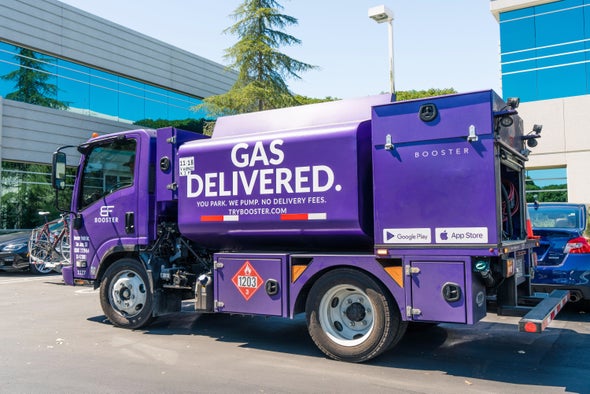Some California drivers no longer go to the gas station—and it’s not because they drive electric cars.
Gasoline increasingly is being delivered into the fuel tanks of cars while their owners work or as they spend time at home.
It’s a trend in Silicon Valley, where technology companies offer fuss-free fill-ups to employees as a perk. They include PayPal, UPS, Facebook, Cisco, IBM and FedEx.
There are also “pop up” gas stations. Motorists can stay in their cars as attendants top off their tanks with refueling trucks.
“People just love the convenience. They love that they don’t have to get out of their cars,’ said Avneesh Nigam, senior director of community relations at Maximus Real Estate Partners, landlord of a 10,000-resident housing community that offers pop-up gas refills.
“They love that it’s contactless,” he added, pointing to the pandemic.
The practice known as “mobile fueling on demand” now is on the radar of both the California Legislature and the state Air Resources Board. The trend has prompted calls for a statewide standard to police the industry and restrict gasoline vapor emissions.
The Air Resources Board, a climate-focused agency, last month issued its first certification that a mobile fuel provider’s system properly limits those emissions. The certification currently isn’t needed to operate, but it can offer a kind of stamp of approval from the regulatory office. Booster Fuels, the gas provider, sought the certification on its own.
Meanwhile, state Assemblymember Bill Quirk (D) has offered a bill, A.B. 905, that would require CARB to issue regulations for vehicles used to deliver the gas and to control emissions from those businesses.
Mobile fueling can reduce “total vehicle miles traveled to gas stations” and lower vapor emissions from gas station pumps, Quirk said in a statement. It also helps drivers with a disability or chronic illness. The bill would set statewide standards.
It comes as California attempts to become the first state to start phasing out gas- and diesel-fueled vehicles. Gov. Gavin Newsom (D) issued an executive order last year banning the sale of new gas-fueled passenger vehicles after 2035.
But the idea of delivering gasoline to motorists “sends a bad message,” said Ethan Elkind, director of the climate program at the University of California, Berkeley’s School of Law.
“Gasoline should be stigmatized to a certain extent as a heavily polluting, environmentally impactful resource,” he said. “We should not be making it easier to fuel up with fossil fuels at this point.”
Joseph Okpaku, chief policy officer at Booster Fuels, defended the practice as a lower-emissions alternative to conventional gas stations.
“Today we provide the most sustainable way to fill up,” he said in an email, “but we are also fully prepared to evolve with the energy demand needs of the future.”
Will refiners leave?
California requires gas stations to install equipment that reduces gasoline vapor emissions through rules known as the Enhanced Vapor Recovery System II. It’s why gas stations in California feature pumps with nozzles that are encased in thick sleeves.
Passenger cars manufactured since 2000 have built-in “on-board refueling vapor recovery” systems. Booster Fuels only refuels vehicles with that equipment. The company’s CARB certification is the first time the agency approved a mobile gas provider’s use of vehicles’ built-in system for vapor recovery.
Booster Fuels uses large purple “mini-tankers” that Okpaku said are its “secret weapon” for delivering fuel in a more environmentally friendly way. The size of the tankers allows the company to fill them up at a refinery terminal before delivering the gas to its customers.
Gas stations receive fuel from tractor-trailers that were filled up at refinery terminals. Fuel gets pumped into underground storage tanks before motorists pump it into gas tanks.
“We are reducing the amount of transfer points, which means reducing the amount of potential for spill,” Okpaku said in an interview.
It also cuts vehicle miles traveled because the fuel is delivered to numerous motorists parked at the same location, such as a parking lot, he said.
Employees of large companies, which sometimes provide the refueling service as a perk, use an app to schedule a fill-up. They can also request more air in their tires or new windshield wipers.
They leave the fuel cap open on their car, and the tank gets filled as they work. Some companies offer a subsidy of between 25 cents and $1 per gallon. Consumer payments are made electronically.
IBM in Silicon Valley offers its workers fill-ups because “we have to be focused on innovative perks that differentiate our facility from others in the Bay Area,” Chris Akey, a program director at IBM, said in a YouTube video.
IBM also offers subsidies for taking mass transit and has EV charging stations on-site, “but we really had a gap in terms of benefits we were offering to people that still drive traditional automobiles,” Akey said.
The COVID-19 pandemic has cut how much some companies currently are using the on-demand gas refueling.
Mobile fueling has existed for years, but it mainly serviced corporate fleets that use diesel, said James Allison, a spokesman for the California Fuels & Convenience Alliance, a trade group for gas station owners. California’s diesel rules don’t require the same vapor recovery system that’s mandated for gas pumps.
Mobile on-demand fueling has been in a kind of regulatory limbo for the last few years, he said.
“Gas stations must have spill plans and vapor recovery equipment,” Allison said in an email. “Currently the On Demand Fuelers are trying to skirt the vapor recovery rules and already do not need a spill plan. ... No one should be exempt from these rules simply because they are new entrants into the market.”
Reprinted from E&E News with permission from POLITICO, LLC. Copyright 2021. E&E News provides essential news for energy and environment professionals.


